Fall Fertilizing and Aeration with Over-Seeding
Fall Fertilization and Aeration with Over-Seeding are the perfect combination. These two services together will benefit your lawn in the spring and the rest of the year.
Why Should you Fertilize your Lawn and Trees this Fall?
Basipetal Translocation of Photoassimilates, (that’s why!)
Ok, that’s just a boring way to say your plants are now manufacturing food (mostly carbohydrates) and moving it to the plant roots.
Fall is the time of year when cool season grasses begin to recover from the stress of summer. If you could only apply one application of fertilizer to your lawn each year, the fall application would be the best option. After the drought, the grass needs all the help it can get.
Also, with adequate moisture and the summer’s hard, dry soil being a thing of the past, our cool season grasses will begin to build up and store food to survive for a long winter.
In late Fall, fertilizer with organic material goes down to the plant roots instead of up to the grass blades. The late fall fertilization should be heavier than any other time of year. During the growing season you do not want to use an excessive amount of fertilizer because it will cause rapid growth of the grass blades. With the cool season and the nutrients going to the roots, this application is very beneficial .
Your grass and tree roots will use some of the “food” during the winter to maintain plant health, but most of it is held in reserve for Spring plant growth.
As the temperature begins to drop in the Fall, the tops of the plants (grass blades and tree leaves) begin to go dormant. However, below the soil surface, the root systems continue to grow and develop. The plant roots will continue to grow all winter as long as the ground is not frozen, which makes fertilization an important last step of the season in a successful lawn and tree care program.
Type of Lawn Fertilizer used in the Fall?
The fertilizer should include a quick-release blend with an abundance of organic matter. In addition to the nutrients 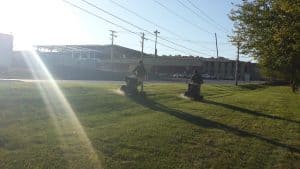 in the organic matter, it also helps loosen the soil density and relieve the easily compacted soil. All of this allows deeper root growth and seed germination in the spring.
in the organic matter, it also helps loosen the soil density and relieve the easily compacted soil. All of this allows deeper root growth and seed germination in the spring.
During the majority of the lawn care season, controlled-release (or ‘slow-release’) fertilizers should be used so the grass receives the nutrients over an extended period of time. However, with winter coming, a fast release fertilizer is best.
Organic-based fertilizers are preferable. (We include as much organic material as possible in our fertilizer applications).
Does Fall Fertilizer need to be watered in?
No, a late fertilizer application does not need to be watered in. The temperatures are cool and rainfall, as well as dew, will work the organic material into the soil.
When should I apply Fall Fertilizer?
Just to clarify, two fall fertilizations are best for a lawn – one early and one late in the fall. This blog is only referring to the late fall treatment.
Be sure you don’t put the late fall fertilization down too early. You don’t want to encourage top-growth – that is, you don’t want to encourage the grass blades to grow at this time of the year.
Dates can vary for any lawn care treatment due to different weather patterns. In general, late fall fertilization should occur when the growth of the grass blades slows down but the grass is still green. Do not fertilize in the extreme cold. You want the fertilizer to nestle into the soil surface and will be there to encourage plant growth in the spring.
Fall begins on September 22 or 23 each year – this is too early for your late fall fertilization. Typically, in Pennsylvania, the earliest we would recommend applying the treatment is the middle of October – and it can be done through December – as long as the ground is not frozen solid.
When Should I Fertilize My Trees in the Fall?
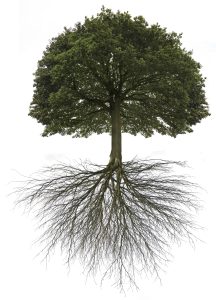
The timing of a fall fertilization of trees and shrubs is also from mid-October through December. The best way to fertilize trees and shrubs is with a Root-Zone fertilization.
Root-Zone treatments distribute to the nutrients in the immediate vicinity of the root system. The liquid fertilizer is injected, under pressure, 2-4 inches under the soil and is readily available to the plants.
Do Tree Spike Fertilizers Work?
Not well. The problem with the fertilizer spikes is that they just dissolve into the small section of soil where the spike is inserted. The root zone will end up with ‘dots’ of nutrients – not an evenly fertilized root zone.
Fall Fertilizer vs. Winterizer – what’s the difference?
‘Winterizer’ fertilizer is simply an informal word that indicates the fertilizer blend is designed for use on lawns in the late fall. The term is synonymous to ‘Late Fall Fertilizer’.
Fall Fertilizing with Weed Control
If you have lawn weeds, you can treat them at the same time you fertilize your grass. The weed killer will take longer to work at this time of year but, it should still work. The weeds need to be actively growing and most products need to be applied when the temperature is above 40 degrees. Always read the label and follow all instructions.
Lawns and trees that have had a late fall fertilization will survive the winter season better and green-up earlier than plants that were not. Fall fertilized plants will have stronger root systems and will also be better prepared to resist damage from diseases and insects.
The benefits are that your lawns and trees will look greener and more lush than lawns and trees that do not have the late season feeding.
Fun Fact:
Fertilizing in the fall is necessary. In fact, plant experts believe the most important fertilizer application is in the fall. So, while you are preparing for Thanksgiving and the Holiday season, don’t forget to feed the plants!
Aeration with Over-Seeding

Core Aeration is the process of punching ‘tine’s into the soil surface, about 2-3 inches deep and pulling the plugs of soil out of the ground.
The plugs contain soil and thatch which break down after mowing. The plugs provide organic matter that will improve soil compaction as it decomposes. The small holes in your lawn to allow water, air and nutrients to reach the grass roots. The 1/2 inch diameter also open up the thatch layer. This all helps the plant roots thrive.
Can I Aerate a Lawn with Golf Spikes?
It might seem like a good idea to use golf spikes because they puncture holes in soil surface, however, the golf spikes actually create more soil compaction. With a core aerator, the soil is pulled out of ground which loosens the soil around the hole. With golf spikes (or any solid spike, soil becomes more compacted. Also, any grass seed that lands in the golf spike holes would have a hard time rooting itself because of the additional compaction.
Can I over-seed over Existing Grass?
Yes, over-seeding is exactly that – it is the process of sowing grass seed over an existing lawn.
Is Lawn Aeration Worth It?
Look at these pictures and you can see what an Aeration with Over-seeding can do.
A 4-foot diameter baby pool was left in the yard all summer. Here you can see the Aeration holes – grass seed was also applied in the Fall.
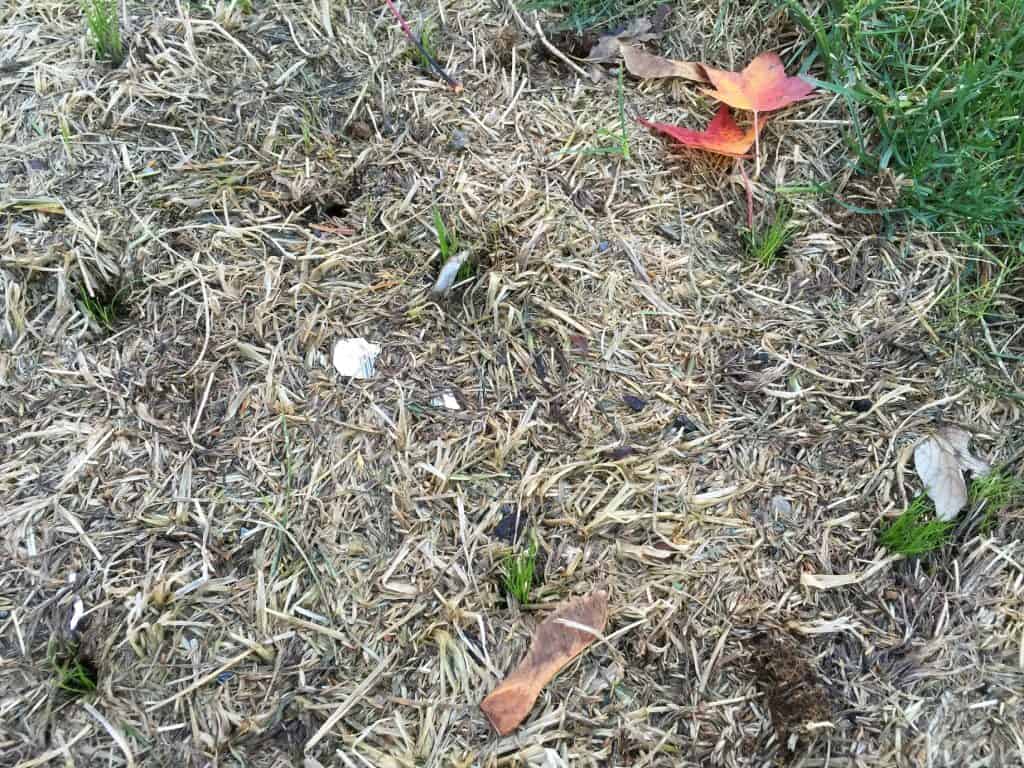
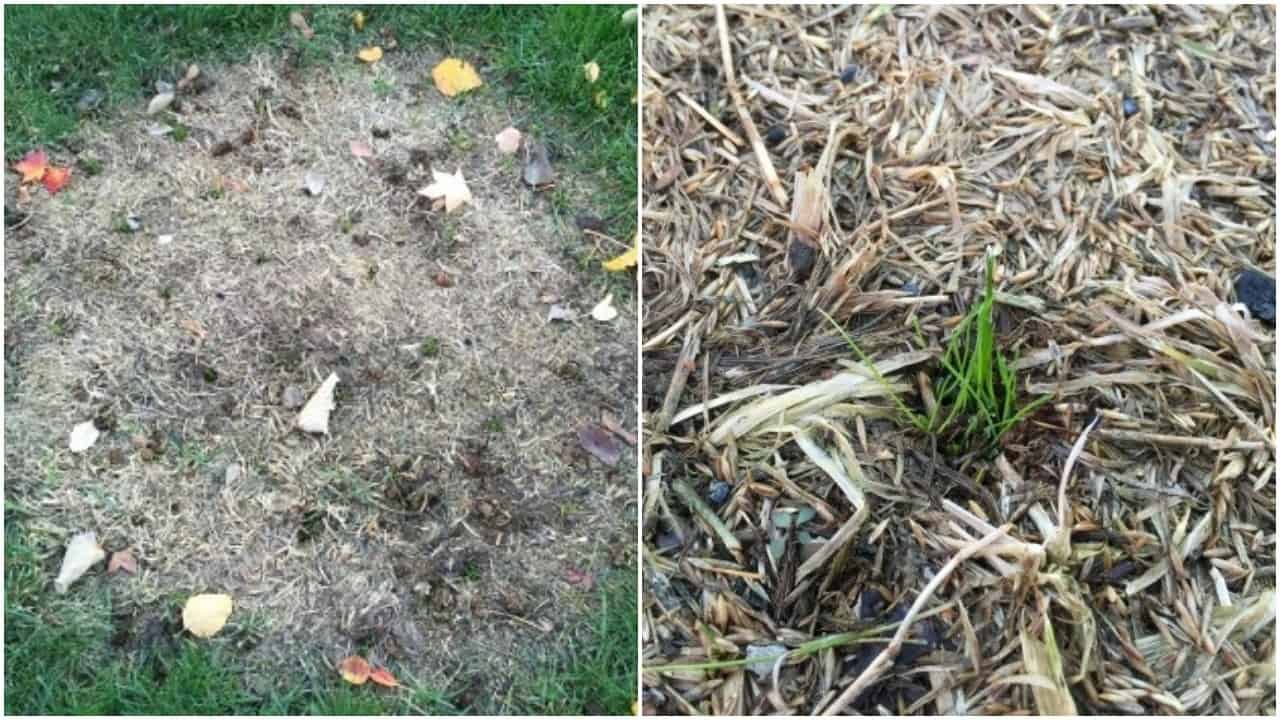
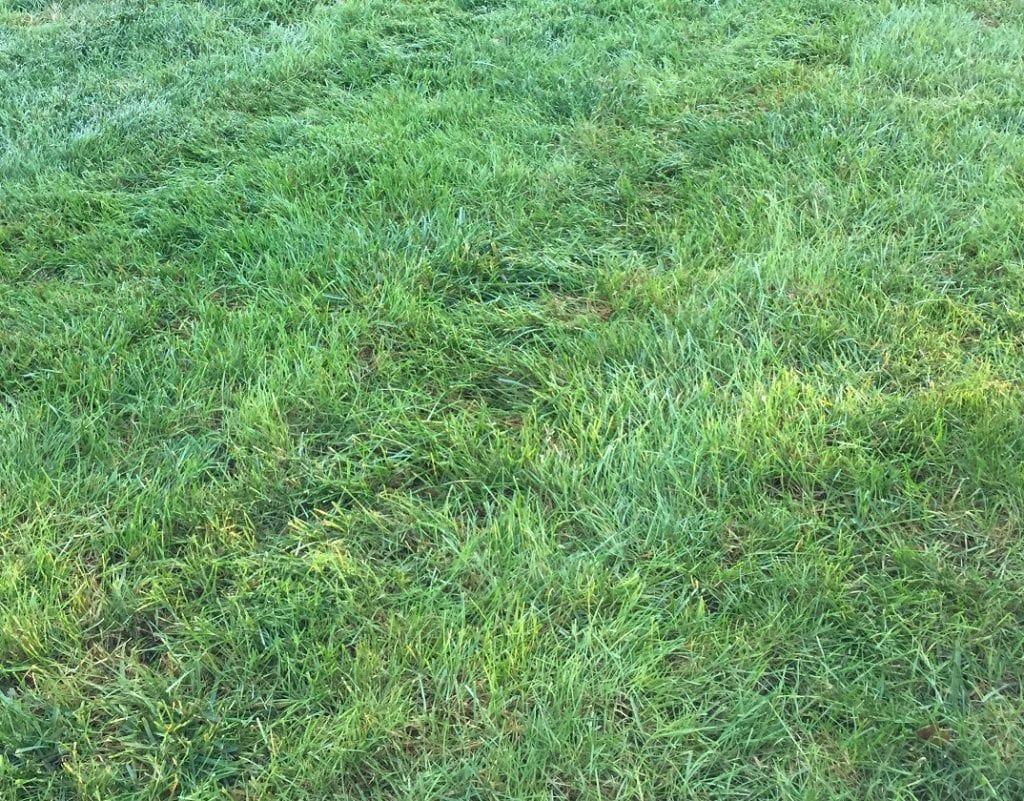
This is the exact same location in the Spring. To see more about this Aeration and Over-Seeding, click here: https://greengianthc.com/lawn-care/lawn-aeration/
What is Thatch?
Thatch is mostly made up of dead and decaying grass plant roots, shoots and stems. The thatch layer creates a barrier between the grass and the soil surface.
Why is Thatch a Problem?
The thatch layer prevents water and nutrients from reaching the roots, and it also provides a perfect environment for insects to harbor. If left unchecked, thatch can eventually kill a lawn by causing it to suffocate. The best way to combat thatch is to aerate the lawn on an annual basis. This will promote healthy grass growth and help to prevent thatch from taking over.
What is Over-Seeding?
Over-Seeding a lawn is simply planting grass seed into an existing lawn to improve its density and introduce better types of grass. Over-Seeding also helps to fill any gaps caused by weeds that have been removed.
The two together help lawns become thick and healthy.
The aeration will reduce soil compaction and provide small holes for seed germination. These holes break the soil surface, loosen up the soil compaction and improves soil porosity.
There are many things the contribute to soil compaction over time. Foot traffic is the most common cause, but lawn mowers, construction activity, heavy rain and even gravity, can compact the soil.
Compacted soil makes it more difficult for grass to grow. Think about it, when the individual soil particles are densely compacted, the tiny grass roots will have a hard time spreading out and getting access to the water and nutrients it needs to thrive.
Soil compaction also leads to less air and water exchange – which is important for all plants. There are many places in Berks County, Chester County, the Lehigh Valley, Lancaster County and Montgomery County that have clay soil. Clay soil is the most easily compacted soil because clay soil particles are the smallest particles in soil.
What Type of Grass Seed to Use?
The type of grass seed that should be used for over-seeding depends on the specific conditions of the lawn. In general, however, it is best to use a mix of grasses that are tolerant to both heat and cold.
If your lawn is in full sun, a mix of Turf Tall Fescue and Perennial Rye is good. Adding a small percentage of Kentucky Bluegrass will help the bare areas fill in. There are many types of soils in Southeast Pennsylvania including clay soil, shale, Birdsboro Red Sandstone and they all do well with these grasses… and all other types of soil in southeastern Pennsylvania.
We do not recommend using 100% Kentucky bluegrass because it is more susceptible to lawn fungus diseases and turf damaging insects. There is actually a type of beetle named Bluegrass Billbug – because it’s favorite lawn to feed on is, you guessed it, Kentucky bluegrass!
Make sure you use cool season grasses. Warm season grasses are used in the south and, if you use them in Pennsylvania, the lawn will be brown from the first freeze in October until about June of the next spring.
Is Aeration Necessary for Over-Seeding?
Over-Seeding by itself does not work very well. The majority of the grass seed that germinates is growing in the aeration holes. The Aeration holes create a very good environment for grass seed germination. The holes provide the seed with a seedbed. The seed is nestled into the soil. There is more moisture available and the seed does not wash away.
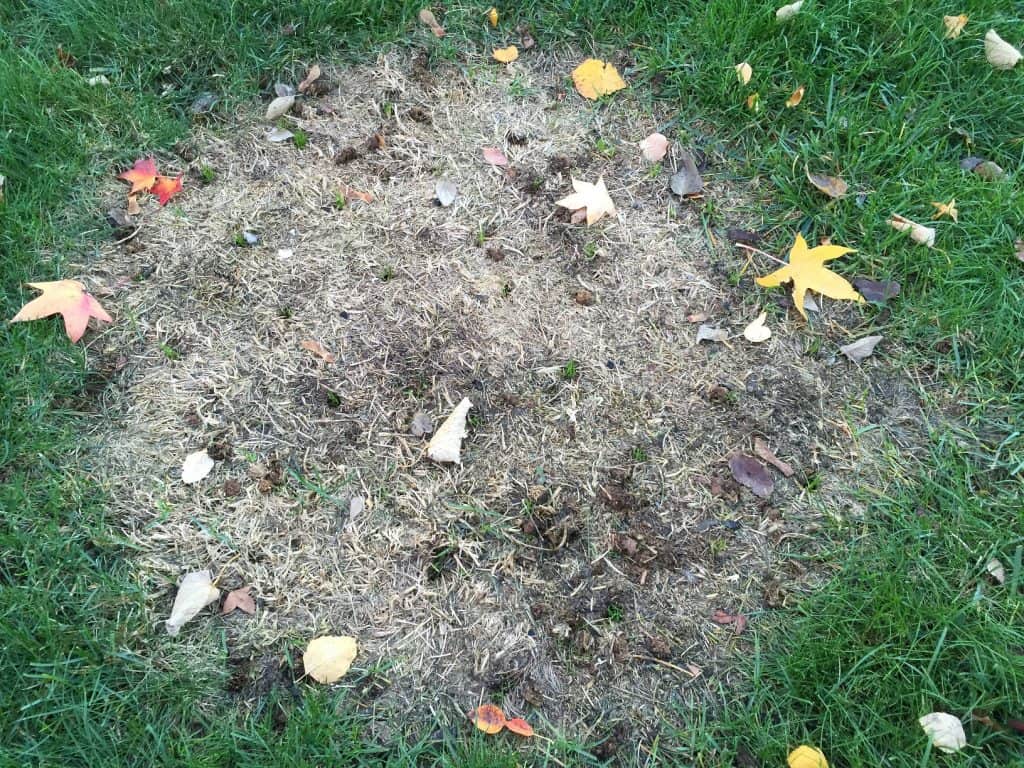
What Should I do After the Aeration and Over-Seeding?
The most important factors are watering and fertilizer. The fertilizer can be applied before or after the aeration and over-seeding.
Watering your lawn after aeration and over-seeding is crucial. The new grass seed needs to be kept moist so it can germinate and grow. Depending on the amount of rainfall, you may need to water every day or two until the new grass is established (usually 3-4 weeks).
In the first week, the grass seed has very small roots so there is no need for deep watering. You only need to use about 1/4 to 1/2 inch of water at a time. But, you should water the grass at least twice a day – morning and afternoon. DO NOT water in the evening – this can cause the new grass to develop fungus.
Seedling emergence will begin within 7-10 days with adequate moisture.
After the first week, you can start to water deeper, but don’t let the ground become saturated causing the grass to wash away. At this point going forward, you always want to do deep watering to encourage deeper root growth. Think about the plant roots – the deeper the plant roots go, the more water and nutrients the roots can absorb.
The best way to water is with a sprinkler on a gentle setting – never use a hose as it can damage the new seedlings as the roots are trying to take hold in the soil.
Is it OK to Mow My Lawn After Aeration and Over-Seeding?
After the aeration and seeding, you do not want to disturb the seed any more than needed. So, mow your lawn a day or two before your lawn is aerated and seeded. Then, hold off on mowing until the grass gets long enough to the point the grass starts laying over. With proper watering, the seed will settle in to the aeration holes and stay put by the next time you need to mow.
Last Mow of the Season
Remember to mow one last time around Thanksgiving. It is best to mow your lawn at about a 2-3-inch height. Leaving your grass long over winter can cause problems with Snow Mold which is a fungus that grown under melting snow. Long grass in the winter also attracts small rodents. A nice ‘haircut’ at the end of the season will help your lawn in the spring.
Can Kids play on the Lawn After Aeration and Over-Seeding?
It is best if you can minimize the activity on your lawn after aeration and seeding. As the new grass seed is starting to grow, the roots are very small and they can easily be pulled out of the ground.
Rake Leaves Off of Your Lawn
Leaves that are left on the lawn over the winter can damage the new grass seedlings and your older grass. The leaves get wet and can smother the grass.
Weed Control After Aeration and Over-Seeding
Weed control should not be used until the grass hardens off so that should wait until Spring.
Green Giant’s Lawn
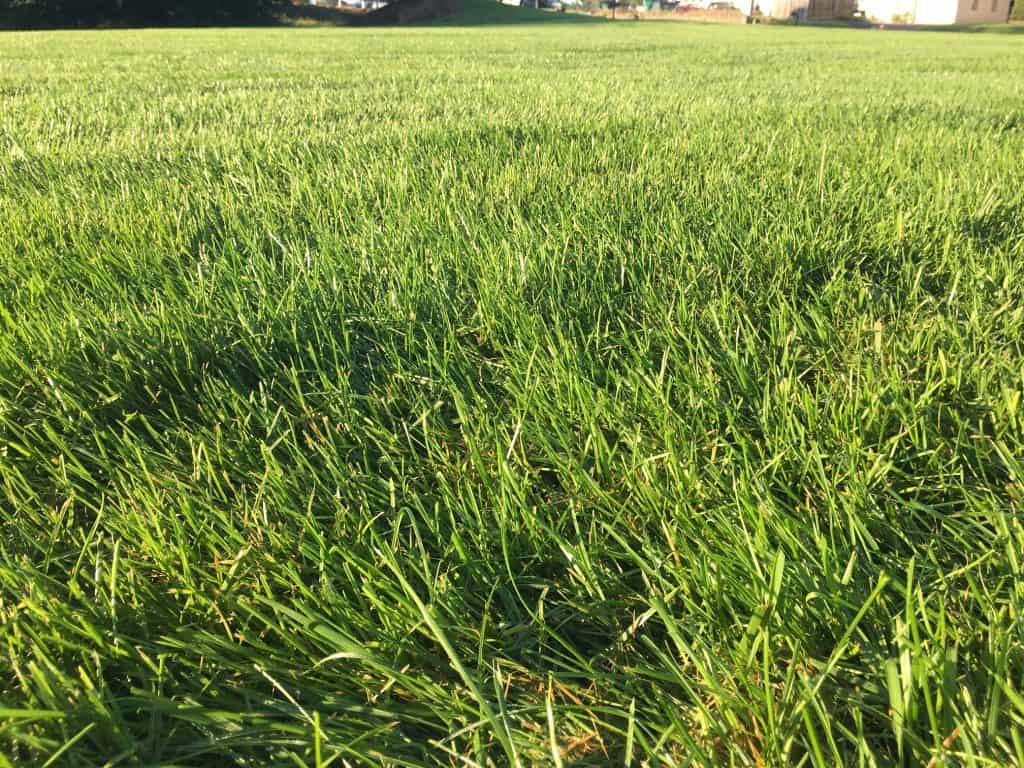
Our lawn care team services the local communities from Reading and Wyomissing to Bethlehem and Kutztown and everywhere in between! Request a Free Estimate!